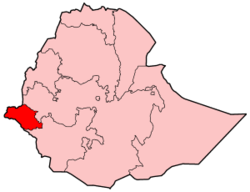
Mezhenger Zone
Encyclopedia

Ethiopia
Ethiopia , officially known as the Federal Democratic Republic of Ethiopia, is a country located in the Horn of Africa. It is the second-most populous nation in Africa, with over 82 million inhabitants, and the tenth-largest by area, occupying 1,100,000 km2...
n Region of Gambela
Gambela Region
Gambela is one of the nine ethnic divisions of Ethiopia. Previously known as "Region 12", its capital is Gambela. Lying between the Baro and Akobo Rivers, the western part of Gambela includes the Baro salient....
; it is named for one of the three largest indigenous groups in Gambela, the Majangir
Majangir
The Majang people, or Majangir, live in southwestern Ethiopia and speak a Nilo-Saharan language of the Surmic cluster. The 1998 census gave the total of the Majangir population as 15,341, but since they live scattered in the hills in dispersed settlements , their actual total number is undoubtedly...
. This zone is bordered on the south and east by the Southern Nations, Nationalities and Peoples Region (SNNPR), on the west by the Anuak Zone, and on the north by the Oromia Region
Oromia Region
Oromia is one of the nine ethnic divisions of Ethiopia...
. Towns in this Zone include Meti.
Overview
The area of the Mezhenger Zone lies to the east of the escarpment which borders the edge of the lowlands which define the majority of the area of the Gambela Region. The terrain is predominantly hilly, and elevations range 550–1260 meters above sea level. According to the Atlas of the Ethiopian Rural Economy published by the Central Statistical AgencyCentral Statistical Agency (Ethiopia)
The Central Statistical Agency is an agency of the government of Ethiopia designated to provide all surveys and censuses for that country used to monitor economic and social growth, as well as to act as an official training center in that field. It is part of the Ethiopian Ministry of Finance and...
(CSA), over 40% of the Zone is forest.
This Zone covers the extent of the original special woreda of Godere, which was made part of the Administrative Zone 2
Administrative Zone 2 (Gambela)
Administrative Zone 2 is one of the three zones of the Ethiopian Region of Gambela; none of the zones of Gambela have names. This zone is bordered by South Sudan and the Southern Nations, Nationalities, and Peoples Region on the south, Administrative Zone 3 on the west, Administrative Zone 1 on the...
between 1994 and 2001. Subsequently, but before 2007, a number of kebele
Kebele
A kebele is the smallest administrative unit of Ethiopia similar to ward, a neighbourhood or a localized and delimited group of people...
s were split off to create Mengesh and both woredas became the Mezhenger Zone.
Demographics
Based on the 2007 Census conducted by the CSA, this Zone has a total population of 59,248, of whom 30,567 are men and 28,681 women; with an area of 2,254.65 square kilometers, Mezhenger Zone has a population density of 26.28. Reportedly 7,140 or 12.05% are urban inhabitants. A total of 15,661 households were counted in this Zone, which results in an average of 3.8 persons to a household, and 15,242 housing units. The main ethnicities of this Zone are the AmharaAmhara people
Amhara are a highland people inhabiting the Northwestern highlands of Ethiopia. Numbering about 19.8 million people, they comprise 26% of the country's population, according to the 2007 national census...
(26.96%), Kafficho (25.17%), Majangir (16.86%), Shakacho (11.67%), Oromo
Oromo people
The Oromo are an ethnic group found in Ethiopia, northern Kenya, .and parts of Somalia. With 30 million members, they constitute the single largest ethnic group in Ethiopia and approximately 34.49% of the population according to the 2007 census...
(8.84%), and all other ethnic groups 10.5%. Languages spoken in this Zone include Amharic
Amharic language
Amharic is a Semitic language spoken in Ethiopia. It is the second most-spoken Semitic language in the world, after Arabic, and the official working language of the Federal Democratic Republic of Ethiopia. Thus, it has official status and is used nationwide. Amharic is also the official or working...
(37.08%), Kafa
Kafa language
Kaffa is an Afroasiatic language spoken in Ethiopia around Bonga in the Keficho Shekicho Zone. The language is also called Kafi nono.- Further reading :...
(22.89%), Sheko
Sheko language
Sheko is an Omotic language of the Afro-Asiatic language family spoken in the area between Tepi and Mizan Teferi in western Ethiopia, in the Sheko district in the Bench Maji Zone...
(12.78%), and Oromiffa
Oromo language
Oromo, also known as Afaan Oromo, Oromiffa, Afan Boran, Afan Orma, and sometimes in other languages by variant spellings of these names , is an Afro-Asiatic language, and the most widely spoken of the Cushitic family. Forms of Oromo are spoken as a first language by more than 25 million Oromo and...
9.91%; only a negligible number of inhabitants speak Majang
Majang language
The Majang language is spoken by the Majangir of Ethiopia. Although it is a member of the Surmic cluster, this language is the most isolated one in that cluster . A language survey has shown that dialect variation from north to south is minor and does not seriously impede communication...
. The religion with the largest number of believers is Orthodox Christian with 46.5% of the population, while other groups with sizable followings are Protestant
P'ent'ay
P'ent'ay or Pentay is a slang term widely used in modern Ethiopia, and among Ethiopians living abroad, to describe Ethiopian Christians who are not members of the Ethiopian Orthodox Tewahedo, Ethiopian Orthodox Tehadeso, Roman Catholic or Ethiopian Catholic churches...
, 36.4%, and Islam
Islam in Ethiopia
According to the latest 2007 national census, Islam is the second most widely practised religion in Ethiopia after Christianity, with over 25 million of Ethiopians adhering to Islam according to the 2007 national census, having arrived in Ethiopia in 615...
15.42%.

